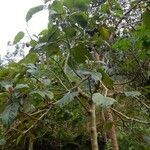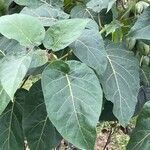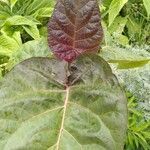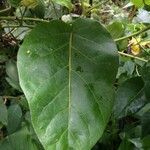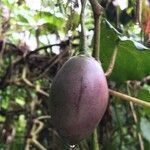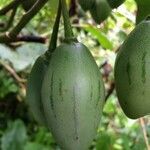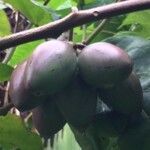Small, malodorous tree, pubescent with simple glandular hairs. Leaves ovate, cordate at base with the lobes overlapping; lamina of the lower and juvenile ones to 35 cm long, 30 cm wide, others commonly c. 15 cm long, 12 cm wide, entire; petiole 5–15 cm long. Inflorescence pendulous, cyme-like; pedicels 10–20 mm long. Calyx c. 5 mm long, the lobes broad, rounded. Corolla c. 20 mm diam., pink, fleshy, scented. Filaments c. 2 mm long; anthers 4–5 mm long, the connective broad and thick. Ovary bluntly conical; style 5–6 mm long, stout. Berry ovoid, 5–7 cm long, dark red, dull. Seeds disc-shaped, 3.5–4 mm diam. with wing 0.25 mm wide, pale reddish brown.
Leaves solitary or rarely geminate; petiole 1.5–11.5 cm long, initially clasping at the base; lamina somewhat fleshy or sub-coriaceous, 4>i>–36 × 1.5>i>–27 cm, cordate or ovate-lanceolate, base cordate and often unequal-sided, apex acute or obtuse, often ± acuminate, entire to slightly 3-lobed (elsewhere sometimes pinnatisect), densely ciliate, finely pubescent, paler and sometimes sub-velvety beneath, with 3–8 pairs of lateral nerves.
Corolla white, ± pink tinged, in bud purple gradually changing to greenish-pink with a dark stripe on the back of each lobe, moderately thick, rotate-campanulate; limb 14>i>–18 mm across; lobes 6>i>–9 mm long, lanceolate, acute or acuminate, densely ciliolate, reflexed.
Fruit yellow to red or purple, 3>i>–5.5 (or more) cm long, ovoid or slightly ellipsoid, smooth, glabrous, somewhat acid, edible, the dissepiment moderately thick, with fleshy, sub-reniform placentas adnate to the middle.
Shrub or small tree, up to 6(7) m high, usually covered with small white, sub-circular or linear spots, somewhat softly and shortly pubescent with simple hairs and papillose glandular hairs to ± glabrous.
Calyx 3.5>i>–4.5 mm long, bowl-shaped or sub-campanulate, shortly spreading pubescent; lobes 1>i>–2 mm long, broadly ovate, somewhat acute or obtuse, in fruit enlarged and strongly thickened.
Stamen filaments 1>i>–1.5 mm long; anthers 4.5>i>–5 mm long, oblong in outline, the connective strongly thickened, dorsally callous or gibbous along the length of the anther.
Cymes ± axillary or supra-axillary, nodding or pendulous, 2>i>–13 cm long, simple or 2>i>–3 times branched, ± densely spreading pubescent.
Flowers fragrant; pedicels 7>i>–12 mm long, slender, thickened upwards; in fruit much elongated and thicker.
Seeds yellowish, 4>i>–5 × 3>i>–4 mm, obovate or elliptic in outline or ± reniform.
Ovary 1>i>–1.5 mm long, conical, ± glabrous; style 5>i>–7 mm long.
A shrub. The commonly used same is Cyphomandra betacea
